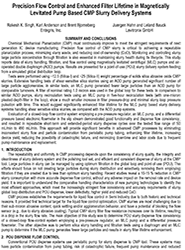

Chemical Mechanical Planarization (CMP) must continuously improve to meet the stringent requirements of next generation IC device manufacturing. Precision flow control of CMP slurry is critical to achieving a repeatable planarization process, minimizing slurry waste, and reducing cost-of-ownership (CoO). Monitoring and controlling slurry large particle concentration through filtration is also essential in maintaining slurry health during its lifecycle. This study reports data of slurry handling, filtration, and flow control using magnetically levitated centrifugal (MLC) pumps and air-operated double diaphragm (AOD) pumps. Results are presented for a point-of-use (POU) slurry delivery system feeding from a simulated global distribution loop.
Tests were performed using ~12.5 (Silica-I) and ~25 (Silica-II) weight percentage of solids silica abrasive oxide CMP slurries. Extensive handling tests of shear-sensitive silica slurries using an AOD pump generated significant number of large particle agglomerates. In similar tests, an MLC pump generated fewer large particles than an AOD pump for comparable turnovers. A filter of nominal rating 1.0 micron was used in the global loop for these tests. In comparison to similar AOD pumps, slurry recirculation tests using an MLC pump in five-hour recirculation tests (with one-micron pleated-depth-filter in the loop), show a much smaller increase in filter pressure-drop and minimal slurry loop pressure pulsation with time. This would suggest significantly enhanced filter lifetime for the MLC pump based slurry delivery systems handling shear sensitive silica slurries, as compared with the AOD pump systems.
Evaluation of a closed-loop flow-control system employing a pre-pressure regulator, an MLC pump, and a differential pressure based electronic flowmeter in the slip stream demonstrated good functionality and dispense flow consistency, and resulted in repeatable short-term and extended-period slurry dispense cycles over the tested flow range of 50 mL/min to 490 mL/min. This approach will provide significant benefits in advanced CMP processes by eliminating inconsistent slurry flow and particle contamination from peristaltic pump tubing, enhancing filter lifetime, increasing device yield, reducing the possibility of catastrophic failure, and minimizing downtime and labor costs due to frequent pump maintenance and replacement.
We found no results for “keyword”
Please check for typos. The product you are searching for may not be a standard Levitronix product or is not yet on our site.
Can`t find what you are looking for?
Contact usYour account has been created and a verification email
has been sent to your registered email address.
Please check on the verification link included in the email to activate your account.
Return to Sign InAlready have an account?
Please enter your information below.
Not a member? Create account
